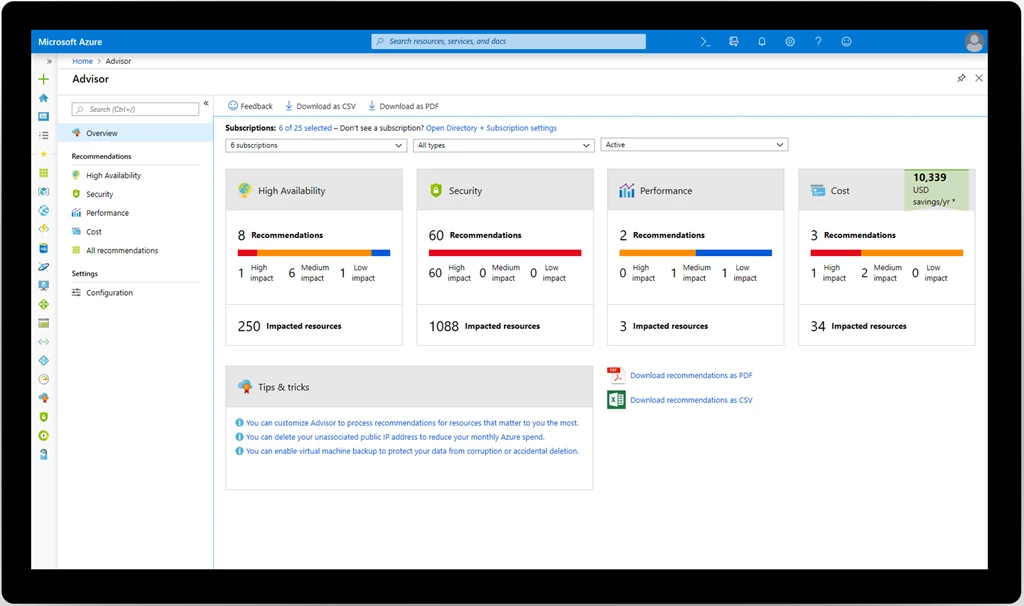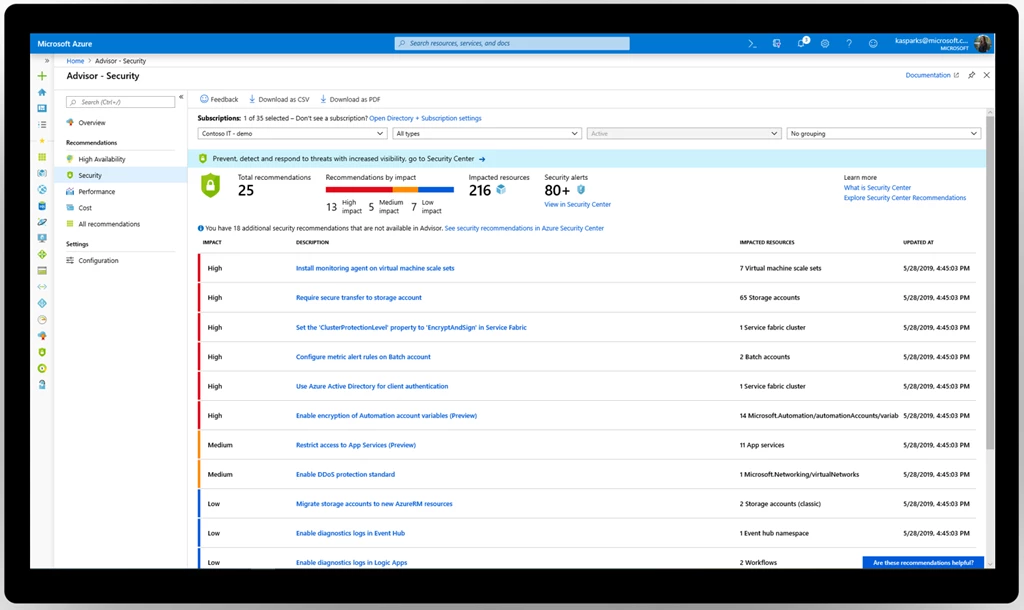Optimizing your Azure workloads can feel like a time-consuming task. With so many services that are constantly evolving it’s challenging to stay on top of, let alone implement, the latest best practices and ensure you’re operating in a cost-efficient manner that delivers security, performance, and reliability.
Many Azure services offer best practices and advice. Examples include Azure Security Center, Azure Cost Management, and Azure SQL Database. But what if you want a single source for Azure best practices, a central location where you can see and act on every optimization recommendation available to you? That’s why we created Microsoft Azure Advisor, a service that helps you optimize your resources for high availability, security, performance, and cost, pulling in recommendations from across Azure and supplementing them with best practices of its own.
In this blog, we’ll explore how you can use Advisor as your single destination for resource optimization and start getting more out of Azure.
What is Azure Advisor and how does it work?
Advisor is your personalized guide to Azure best practices. It analyzes your usage and configurations and offers recommendations to help you optimize your Azure resources for high availability, security, performance, and cost. Each of Advisor’s recommendations includes suggested actions and sharing features to help you quickly and easily remediate your recommendations and optimize your deployments. You can also configure Advisor to only show recommendations for the subscriptions and resource groups that mean the most to you, so you can focus on critical fixes. Advisor is available from the Azure portal, command line, and via REST API, depending on your needs and preferences.

Ultimately, Advisor’s goal is to save you time while helping you get the most out of Azure. That’s why we’re making Advisor a single, central location for optimization that pulls in best practices from companion services like Azure Security Center.
How Azure Security Center integrates with Advisor
Our most recent integration with Advisor is Azure Security Center. Security Center helps you gain unmatched hybrid security management and threat protection. Microsoft uses a wide variety of physical, infrastructure, and operational controls to help secure Azure—but there are additional actions you need to take to help safeguard your workloads. Security Center can help you quickly strengthen your security posture and protect against threats.
Advisor has a new, streamlined experience for reviewing and remediating your security recommendations thanks to a tighter integration with Azure Security Center. As part of the enhanced integration, you’ll be able to:
- See a detailed view of your security recommendations from Security Center directly in Advisor.
- Get your security recommendations programmatically through the Advisor REST API, CLI, or PowerShell.
- Review a summary of your security alerts from Security Center in Advisor.

The new Security Center experience in Advisor will help you more quickly and easily remediate security recommendations.
How Azure Cost Management integrates with Advisor
Another Azure service that provides best practice recommendations is Azure Cost Management, which helps you optimize cloud costs while maximizing your cloud potential. With Cost Management, you can monitor your spending, increase your organizational accountability, and boost your cloud efficiency.

Advisor and Cost Management are also tightly integrated. Cost Management’s integration with Advisor means that you can see any cost recommendation in either service and act to optimize your cloud costs by taking advantage of reservations, rightsizing, or removing idle resources.
Again, this will help you streamline your optimizations.
Azure SQL DB Advisor, Azure App Service Advisor, and more
There’s no shortage of advice in Azure. Many other services including Azure SQL Database and Azure App Service include Advisor-like tools designed to help you follow best practices for those services and succeed in the cloud.
Advisor pulls in and displays recommendations from these services, so the choice is yours. You can review the optimizations in context—in a given instance of an Azure SQL database, for example—or in a single, centralized location in Advisor.

We often recommend the Advisor approach. This way, you can see all your optimizations in a broader, more holistic context and remediate with the big picture in mind, without worrying that you’re missing anything. Plus, it’ll save you time switching between different resources.
Review your recommendations in one place with Advisor
Our recommendation? Use Advisor as your core resource optimization tool. You’ll find everything in a single location rather than having to visit different, more specialized locations. With the Advisor API, you can even integrate with your organization’s internal systems—like a ticketing application or dashboard—to get everything in one place on your end and plug into your own optimization workflows.
Visit Advisor in the Azure portal to get started reviewing, sharing, and remediating your recommendations. For more in-depth guidance, visit the Azure Advisor documentation. Let us know if you have a suggestion for Advisor by submitting an idea here in the Advisor forums.
